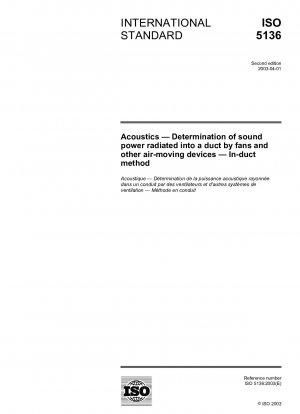ISO 5136:2003
Acoustics - Determination of sound power radiated into a duct by fans and other air-moving devices - In-duct method
- Standard No.
- ISO 5136:2003
- Release Date
- 2003
- Published By
- International Organization for Standardization (ISO)
- Latest
- ISO 5136:2003
- Scope
- 1 General This International Standard specifies a method for testing ducted fans and other air-moving devices to determine the sound power radiated into an anechoically terminated duct on the inlet and/or outlet side of the equipment. NOTE 1 For the sake of brevity, wherever the term "fan" occurs in the text, it means "fan or other air-moving device". The method is applicable to fans which emit steady, broad-band, narrow-band and discrete-frequency sound and to air temperatures between - 50 ℃ and + 70 ℃. The test duct diameter range is from 0,15 m to 2 m. Test methods for small (d < 0,15 m) and large (d > 2m) test ducts are described in the informative Annexes H and I, respectively. The maximum mean flow velocity at the microphone head for which the method is suitable depends on the type of microphone shield used, and is as follows: — foam ball 15 m/s; — nose cone 20 m/s; — sampling tube 40 m/s. Above these values the suppression of turbulent pressure fluctuations by the microphone shield (see 3.9) may be insufficient. It is expected that sound power tests will be conducted in conjunction with airflow performance tests in accordance with ISO 5801. The ducting arrangement will therefore normally incorporate a "star" type flow straightener on the outlet side of the fan which will minimize swirl (see 7.3). Where it is permissible to delete the straightener as, for example, with large fans to installation category C according to ISO 5801:1997, the method is limited to a swirl angle of 15° (An example of a method for determining the angle of swirl is given in Annex J.) NOTE 2 The installation categories defined in ISO 5801 imply that the fan is either ducted on the outlet side only (category B), on the inlet side only (category C) or on both sides (category D). 2 Types of sound source The method described in this International Standard is applicable to a sound source in which a fan is connected to ducts on at least one side. It is also applicable to other fan/attenuator combinations or equipment incorporating fans which can be considered as "black boxes". Examples of fans and other equipment covered by this International Standard are — ducted centrifugal fans, — ducted axial flow fans, — ducted mixed-flow fans, — ducted air-handling units, — ducted dust-collection units, — ducted air-conditioning units, and — ducted furnaces. This International Standard is also applicable to other aerodynamic sources such as boxes, dampers and throttle devices provided that a quiet air flow delivered by an auxiliary fan is available, and the signal-to-noise ratio of sound pressures to turbulent pressure fluctuations in the test duct is at least 6 dB (see 7.2.1). An alternative method to determine the sound power level of the flow-generated noise of such aerodynamic sound sources, which does not require the measurement of sound pressure in a flow environment, is described in ISO 7235. The method was originally devised for the determination of the flow noise level of ducted silencers. The sound power is determined in a reverberation room connected to the test duct via a transition element. In the case of ducted fans with closely coupled attenuators, the signal-to-noise ratio of sound pressures to turbulent pressures may be insufficient when using the in-duct method. Therefore the method described in ISO 7235 is recommended for such fan/attenuator combinations. This International Standard is not applicable to non-ducted fans or equipment.
ISO 5136:2003 history
- 2003 ISO 5136:2003 Acoustics - Determination of sound power radiated into a duct by fans and other air-moving devices - In-duct method
- 1993 ISO 5136:1990/Cor 1:1993 Acoustics; determination of sound power radiated into a duct by fans; in-duct method; technical corrigendum 1
- 1990 ISO 5136:1990 Acoustics; determination of sound power radiated into a duct by fans; in-duct method
